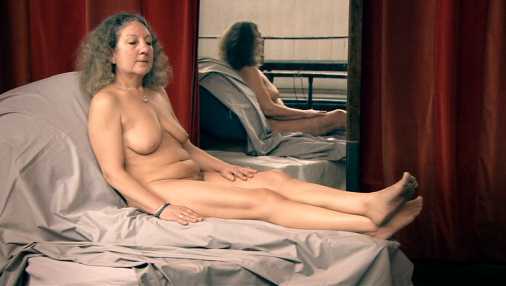
Channel 4
Life Modelling TV Programme
In July 2009 the
UK TV channel C4 broadcast 5 programmes showing a life drawing
class in action. It was not quite the real thing as there were
no students, but just the tutor and the model. The programme
was broadcast at mid-day. Nudity on UK TV is normally reserved
for aftere the 'watershead' which is 9pm. However C4 decided
that as it was an educational programme, and not really showing
much more than you would see from statues at a museum, then the
mid-day slot was appropriate for such a programme.
The programme was
a fair representation of what goes on during a life drawing class.
However it did upset some people as it did show nudity before
the watershed, and there were concerns that children might have
seen the nude models.
The Sunday Telegraph
did an excellent write up of the series, which I've appended
below, along with some screenshots of the programme. The write
up touches on the complaints recieved about the programme and
the potential effects on children. It takes a massive swipe at
all the people who would protect children from the sight of a
nude body, and claims that it should be part of parential responsibility
to educate their children as to how the average nude body looks
like, rather than the air-brushed representations that genarally
adorn the media!
Read on.............
Nudity
does us all good
Channel 4's
Life Class delivers an important lesson on the human form, whatever
the moral guardians of daytime TV say, writes Jemima Lewis.
By Jemima Lewis
 "Art
can never exist without naked beauty displayed," said William
Blake. But the moral guardians of daytime TV take a different
view. The Channel 4 programme Life Class caused conniptions last
week by showing a woman sitting very still with no clothes on. "Art
can never exist without naked beauty displayed," said William
Blake. But the moral guardians of daytime TV take a different
view. The Channel 4 programme Life Class caused conniptions last
week by showing a woman sitting very still with no clothes on.
The point of the programme is to replicate a real life class,
with the viewers at home encouraged to pick up a pencil. The
camera stays fixed on the model from one angle, only occasionally
cutting away to take a peek at what the "tutor" - one
of a series of distinguished artists - has drawn.
It is filmed in a determinedly untitillating way, more Open University
than Nuts magazine, and in fact the first three episodes went
out last week without any kerfuffle. It was only on Thursday
- when Kirsten Varley, a fashion model of uncommon loveliness,
dropped her silky dressing gown and stepped on to the dais -
that the forces of puritanism pricked up their ears.
 Channel 4 was said to have
had dozens of complaints: one viewer, who watched the programme
while ill in bed, croaked: "It nearly gave me a relapse.
It was adult viewing, not for screening in the middle of the
day." John Beyer, of the TV pressure group Mediawatch UK,
said he had referred the matter to Ofcom after being contacted
by scandalised parents. "Obviously, people feel this is
not suitable for daytime TV when they have children at home,"
he opined. "It's a pity Channel 4 cannot revive its Watercolour
Challenge show." Channel 4 was said to have
had dozens of complaints: one viewer, who watched the programme
while ill in bed, croaked: "It nearly gave me a relapse.
It was adult viewing, not for screening in the middle of the
day." John Beyer, of the TV pressure group Mediawatch UK,
said he had referred the matter to Ofcom after being contacted
by scandalised parents. "Obviously, people feel this is
not suitable for daytime TV when they have children at home,"
he opined. "It's a pity Channel 4 cannot revive its Watercolour
Challenge show."
We all miss Watercolour Challenge, John, but there comes a time
when you have to let go. As for the effect of Life Class on young
minds: who are these children who have never seen a naked body
before? And more importantly, why not?
Going naked in front of your offspring is one of the duties of
parenthood. Studies show - and common sense suggests - that children
from households where nudity is commonplace grow up to feel more
comfortable in their own skin. We need the background scenery
of other people's bodies - dumpy, scrawny, dimpled or lean -
in order to be reassured that our own peculiarities are normal.
 Especially now, when most public
images of the human form are airbrushed into a preposterous lie,
children ought to know what actual people look like under their
clothes. Thanks to the internet, a generation of boys is growing
up submerged in the fake aesthetic of pornography - as ignorant
of real female beauty as the Victorian art critic John Ruskin,
who discovered on his wedding night that women have pubic hair,
and was so disgusted that he refused to consummate the marriage.
Life classes, like naked parents, are a no-strings-attached opportunity
to see what other people are really made of. Especially now, when most public
images of the human form are airbrushed into a preposterous lie,
children ought to know what actual people look like under their
clothes. Thanks to the internet, a generation of boys is growing
up submerged in the fake aesthetic of pornography - as ignorant
of real female beauty as the Victorian art critic John Ruskin,
who discovered on his wedding night that women have pubic hair,
and was so disgusted that he refused to consummate the marriage.
Life classes, like naked parents, are a no-strings-attached opportunity
to see what other people are really made of.
Some of my favourite memories of school feature middle-aged men
and women disporting themselves in the buff. Our A-level teacher,
like many artists, preferred her life models on the well-fed
side, their rolls of fat allowing for plentiful chiaroscuro.
Often, when a new model first disrobed, the unfamiliar droops
and bulges seemed indecently ugly. But you need a lot of confidence
to strike a pose for two hours under the scrutiny of a classroom
full of teenagers; and in the end, it was this that impressed
itself on our tender psyches. The ease with which those models
carried themselves was transformative: their imperfections ceased
to look strange and became distinguished.
Although it is a long time since I picked up a sketchpad, those
life classes, combined with the tireless domestic nudity of my
parents, are proving more useful to me now than ever. Age and
childbirth are taking their toll, but what I see in the mirror
does not - yet - fill me with despair.
I know that you can find beauty in much more unruly landscapes,
and that there is no point hankering after a template of perfection
that does not exist. Or as the painter Maggie Hambling advises
in Life Class: "Keep your eye on the model - on the truth."
Back to my Life Drawing Webpage
Navigate
Yourself Around my Web Pages

|


 "Art
can never exist without naked beauty displayed," said William
Blake. But the moral guardians of daytime TV take a different
view. The Channel 4 programme Life Class caused conniptions last
week by showing a woman sitting very still with no clothes on.
"Art
can never exist without naked beauty displayed," said William
Blake. But the moral guardians of daytime TV take a different
view. The Channel 4 programme Life Class caused conniptions last
week by showing a woman sitting very still with no clothes on.
 Channel 4 was said to have
had dozens of complaints: one viewer, who watched the programme
while ill in bed, croaked: "It nearly gave me a relapse.
It was adult viewing, not for screening in the middle of the
day." John Beyer, of the TV pressure group Mediawatch UK,
said he had referred the matter to Ofcom after being contacted
by scandalised parents. "Obviously, people feel this is
not suitable for daytime TV when they have children at home,"
he opined. "It's a pity Channel 4 cannot revive its Watercolour
Challenge show."
Channel 4 was said to have
had dozens of complaints: one viewer, who watched the programme
while ill in bed, croaked: "It nearly gave me a relapse.
It was adult viewing, not for screening in the middle of the
day." John Beyer, of the TV pressure group Mediawatch UK,
said he had referred the matter to Ofcom after being contacted
by scandalised parents. "Obviously, people feel this is
not suitable for daytime TV when they have children at home,"
he opined. "It's a pity Channel 4 cannot revive its Watercolour
Challenge show."  Especially now, when most public
images of the human form are airbrushed into a preposterous lie,
children ought to know what actual people look like under their
clothes. Thanks to the internet, a generation of boys is growing
up submerged in the fake aesthetic of pornography - as ignorant
of real female beauty as the Victorian art critic John Ruskin,
who discovered on his wedding night that women have pubic hair,
and was so disgusted that he refused to consummate the marriage.
Life classes, like naked parents, are a no-strings-attached opportunity
to see what other people are really made of.
Especially now, when most public
images of the human form are airbrushed into a preposterous lie,
children ought to know what actual people look like under their
clothes. Thanks to the internet, a generation of boys is growing
up submerged in the fake aesthetic of pornography - as ignorant
of real female beauty as the Victorian art critic John Ruskin,
who discovered on his wedding night that women have pubic hair,
and was so disgusted that he refused to consummate the marriage.
Life classes, like naked parents, are a no-strings-attached opportunity
to see what other people are really made of.